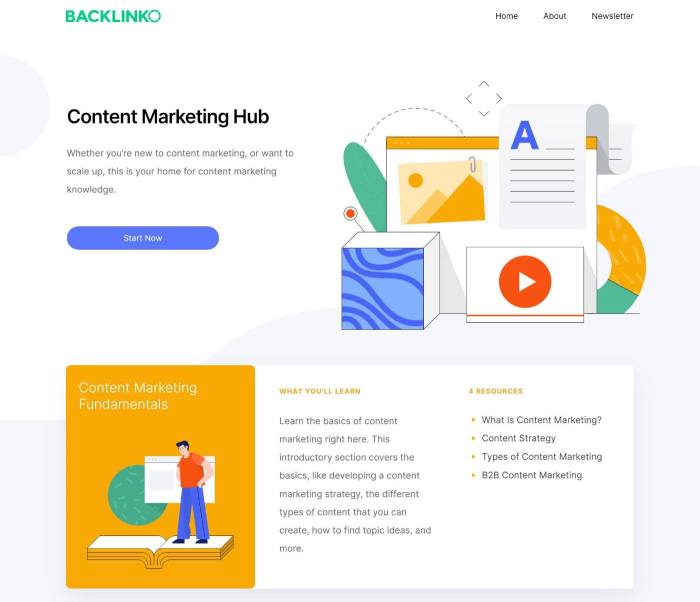Launching a Content Hub dives into the world of digital marketing with a bang, showcasing the key elements needed to create a successful hub that resonates with your audience. From planning to implementation, this guide will equip you with the knowledge to elevate your brand’s online presence.
Introduction to Content Hub
A content hub is a centralized platform where businesses can create, organize, and distribute valuable content to their target audience. It serves as a one-stop destination for all relevant information, resources, and updates related to a particular topic or industry.
Content hubs play a crucial role in digital marketing by enhancing brand visibility, establishing thought leadership, and engaging with customers in a meaningful way. They help businesses attract and retain customers by providing them with valuable insights, solutions, and entertainment.
Examples of Successful Content Hubs
- Red Bull’s Media House: Red Bull has created a media hub that produces high-quality content related to extreme sports, music, and lifestyle. This content hub has helped the brand connect with its target audience, build a loyal community, and drive brand awareness.
- HubSpot’s Knowledge Base: HubSpot’s knowledge hub is a valuable resource for marketers, providing them with expert advice, best practices, and industry insights. This content hub has positioned HubSpot as a thought leader in the marketing industry and attracted a large following of loyal customers.
- Nike’s Product Hub: Nike’s product hub showcases its latest products, offers exclusive content, and engages with customers through interactive experiences. This content hub has helped Nike drive sales, create brand loyalty, and differentiate itself from competitors.
Comparison of Different Types of Content Hubs
| Content Hub Type | Purpose |
|---|---|
| Media Hub | Entertain, inspire, and engage audience through multimedia content |
| Knowledge Hub | Educate, inform, and empower audience with valuable information and resources |
| Product Hub | Showcase products, drive sales, and enhance customer experience |
Planning a Content Hub
When it comes to planning a content hub, there are several key steps to consider in order to ensure its success. From defining goals and identifying target audiences to conducting market research and aligning with overall marketing strategy, each step plays a crucial role in the planning process.
Defining Goals
Defining clear and specific goals for your content hub is essential. Whether it’s increasing brand awareness, driving website traffic, or generating leads, having a clear understanding of what you want to achieve will shape the entire content strategy.
Identifying Target Audience
Understanding your target audience is crucial for creating relevant and engaging content. Conducting thorough research to identify their preferences, pain points, and interests will help tailor your content to meet their needs effectively.
Content Types, Launching a Content Hub
Deciding on the types of content to include in your hub is another important step. Whether it’s blog posts, videos, infographics, or podcasts, choosing the right mix of content formats will help keep your audience engaged and coming back for more.
Conducting Market Research
Market research plays a vital role in identifying content needs for your hub. By analyzing industry trends, competitor strategies, and audience behavior, you can uncover valuable insights that will guide your content creation process.
Aligning with Marketing Strategy
Aligning your content hub with the overall marketing strategy of the business is key to ensuring consistency and effectiveness. By integrating your content efforts with other marketing initiatives, you can maximize the impact of your content and drive towards your business goals effectively.
Creating Content for the Hub: Launching A Content Hub

Creating content for a content hub involves utilizing various formats to engage and inform your audience. Here, we will explore different content formats, maintaining consistency in branding and messaging, and repurposing content for maximum impact.
Different Content Formats
- Articles: Comprise written content that informs, educates, or entertains the audience.
- Videos: Engage viewers visually, providing a dynamic way to deliver information.
- Podcasts: Offer an audio format for listeners to consume content on-the-go.
Maintaining Brand Consistency
Consistency in branding and messaging is crucial for establishing a strong identity and connection with your audience. To maintain consistency:
- Use the same color palette, fonts, and logo across all content.
- Ensure messaging aligns with your brand values and tone of voice.
- Create brand guidelines to provide a clear framework for content creation.
Repurposing Content Strategies
Repurposing content allows you to reach a wider audience and maximize the impact of your message. Strategies for repurposing content include:
- Turn blog posts into videos or podcasts to cater to different preferences.
- Create infographics or slideshows using data from existing articles.
- Share snippets or quotes from longer content on social media to drive traffic back to your hub.
Implementing the Content Hub

Implementing a content hub involves several technical aspects to ensure it functions effectively and attracts the right audience. This includes choosing the right platform, designing a user-friendly layout, organizing content effectively, and optimizing the hub for .
Choosing the Platform
When selecting a platform for your content hub, consider factors like ease of use, customization options, scalability, and integration with other tools. Popular platforms like WordPress, HubSpot, and Drupal offer robust features for content management and distribution.
Designing the Layout
The layout of your content hub should be intuitive and visually appealing to engage visitors. Use clear navigation menus, relevant categories, and a responsive design to ensure a seamless user experience across different devices.
Organizing and Categorizing Content
Best practices for organizing content within the hub include creating distinct categories based on topics or themes, using tags and metadata for easy searchability, and establishing a logical hierarchy for navigation. This helps users find relevant content quickly and improves overall site usability.
Optimizing for
To enhance visibility and search rankings, optimize your content hub for by incorporating relevant s, writing compelling meta descriptions, creating unique and valuable content, and obtaining backlinks from reputable sources. Regularly monitor performance using tools like Google Analytics to track progress and make necessary adjustments.





